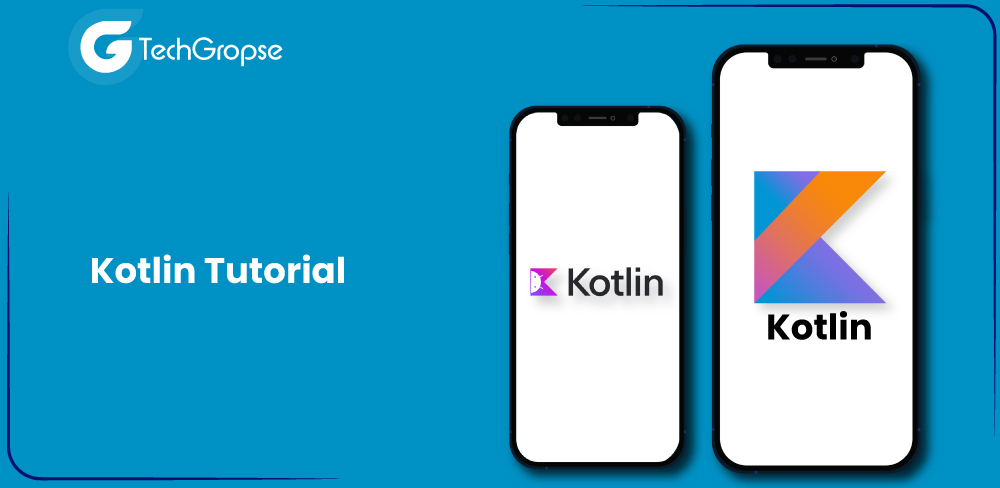Kotlin is a cross-platform programming language for modern multi-platform applications developed by JetBrains. It has quickly achieved popularity in recent years due to its interoperability with Java, concise syntax, and safety features.
Kotlin takes inspiration from Java, Scala, C#, and Groovy but its syntax is more streamlined and expressive. This tutorial offers a comprehensive guide to Kotlin programming language, covering its basic syntax, control flow, data types, exception handling, object-oriented programming, and more.
Whether you are a beginner or an experienced developer, this tutorial will help you understand and use Kotlin effectively in your projects.
What is Kotlin?
Kotlin is widely used for designing Android applications, but it can also be used for web applications, server-side development, and other types of software. Its combination of modern language features, strong Java interoperability, and extensive tooling support has made it a famous choice among developers.
It is achieving popularity in the development community as it offers various benefits over other programming languages.
One of the major reasons to use Kotlin is its flexibility and interoperability with Java, which makes it easy to integrate with existing Java code. It is also more concise, which means that developers can write fewer lines of code to achieve the same functionality.
Basically, Kotlin was first presented by JetBrains in 2011 as a new programming language for the Java Virtual Machine (JVM). Its first official out was in February 2016.
Since then, Kotlin has attained popularity among developers and has been adopted by various companies such as Google, which added support for Kotlin in its Android development toolkit in 2017.
Key Features of Kotlin Language
Kotlin is designed to be fully interoperable with Java, meaning it can seamlessly combine with existing Java codebases and libraries. Here are some essential features including:
- Concise Syntax: Kotlin offers a more brief syntax compared to Java, reducing boilerplate code and enhancing readability.
- Null Safety: Kotlin handles the issue of null pointer exceptions by including null safety features in its type system. It enforces non-nullability by default, reducing the chances of encountering null-related errors.
- Extension Functions: Kotlin allows developers to add new functions to existing classes without modifying their source code. This feature allows cleaner, called extension functions, and more definitive code.
- Smart Casts and Type Inference: Kotlin’s type inference capabilities make code more concise and readable. It can automatically select the type of variables, reducing the requirement for explicit type declarations. Additionally, Kotlin’s smart casts eliminate the need for type checks and explicit casting.
- Coroutines: Kotlin offers built-in support for coroutines, which are lightweight threads used for asynchronous programming. Coroutines simplify asynchronous code by allowing developers to write asynchronous code in a sequential manner, resulting in more readable and maintainable code.
- Data Classes: Kotlin delivers data classes, which are used to describe data in a concise and straightforward manner. Data classes automatically develop useful methods such as hashCode(), equals(), and toString(), reducing the boilerplate code required for data manipulation.
- Interoperability: Kotlin can seamlessly interoperate with Java code, allowing developers to introduce Kotlin into existing Java projects. Kotlin code can call Java code, and vice versa, without any compatibility issues.
Brief Tutorial With Kotlin Programming
Certainly! Here’s a brief tutorial to get started with Kotlin programming:
1. Setting Up Kotlin
- Install the Java Development Kit (JDK) on your computer.
- Download and install an Integrated Development Environment (IDE) that supports Kotlin, such as IntelliJ IDEA or Android Studio.
2. Hello World
- Open your Kotlin IDE and create a new Kotlin project.
- Create a new Kotlin file and name it “HelloWorld.kt”.
- Inside the file, write the following code:
fun main()
{
println("Hello, World!")
}
- Run the program, and you should see “Hello, World!” printed in the console.
3. Variables and Data Types
- Kotlin provides type inference, so you don’t always need to explicitly specify the data type.
- Declare variables using the “val” (immutable) or “var” (mutable) keyword.
- Example:
val name = "John" //
Immutable variable var age: Int = 25 //
Mutable variable with explicit type declaration
4. Conditional Statements
- Use “if” and “when” statements for conditional branching.
- Example:
val number = 5
if (number > 0)
{
println("Positive")
}
else if (number < 0) { println("Negative") } else { println("Zero") } when (number) { 1 -> println("One") 2 -> println("Two") else -> println("Other")
}
5. Loops
- Use “for” and “while” loops for iteration.
- Example
for (i in 1..5)
{
println(i)
}
var i = 1
while (i <= 5)
{
println(i) i++
}
6. Functions
- Declare functions using the “fun” keyword.
- Example:
fun greet(name: String)
{
println("Hello, $name!")
}
greet("Alice")
Basic Syntax and Data Types
1. Data Types in Kotlin
Kotlin supports different data types like characters, numbers, booleans, and strings. It also has special types such as collections, and arrays. In Kotlin, every variable has to be declared with its data type, which can be done using the “var” or “val” keyword.
2. Variables and Constants
In Kotlin, variables are declared using the “var” keyword, on the other hand, constants are declared using the “val” keyword. Once a value is assigned to a constant, it cannot be changed. While a variable can have its value changed during the program execution.
3. Operators
Kotlin supports different operators like comparison operators (==, !=, >, <, >=, <=), arithmetic operators (+, -, *, /), and logical operators (&&, ||, !). These operators work similarly to those in other programming languages.
4. Control Structures
Kotlin supports multiple control structures like when statements, if-else statements, loops, and try-catch blocks. These help developers control the flow of the program and make decisions based on specific conditions.
Control Flow and Loops
1. If-else statements
If-else statements are used to make decisions based on particular conditions. In Kotlin, if-else statements can be used as expressions, which means that they can return a value.
2. When statement
The when statement is the same as a switch statement in other programming languages. It enables developers to match a value against a set of possible values and execute the corresponding code block.
3. For loop
A for loop is used to iterate about a range or a collection of elements. In Kotlin, for loops can be used with lists, arrays, maps, and other collections.
4. While loop
A while loop is used to repeatedly execute a block of code as long as a particular condition is true. In Kotlin, while loops can be used with any boolean expression.
Functions and Lambdas
Functions in Kotlin
Functions are used to encapsulate a piece of code that can be reused at various times. In Kotlin, functions can have optional parameters and a return type.
Named arguments & default arguments
Kotlin supports default arguments and named arguments, which means that a function can have a default value for its parameters. Named arguments, which allow developers to pass arguments to a function in any order.
Variadic functions
Variadic functions are functions that can take a variable number of arguments. In Kotlin, variadic functions can be implemented using the “vararg” keyword.
Higher-Order Functions and Lambdas
Higher-order functions are functions that take one or more than one function as input or return a function as a result. Lambdas are anonymous functions that can be used as input parameters for higher-order functions. In Kotlin, these features allow developers to write more expressive and summaries code.
Object-Oriented Programming (OOP) Concepts in Kotlin
Kotlin, like all modern programming languages, worked on Object-Oriented Programming (OOP) principles. These concepts are fundamental to understanding the language and how to use it in an effective way.
Classes and Objects
Classes and objects are the basic building blocks of Kotlin’s OOP structure. A class is a blueprint for making objects, while an object is an instance of a class. In Kotlin, classes are described as the “class” keyword, and objects are created using the “new” keyword.
Constructors
Constructors are special functions that are used to create objects of a class. In Kotlin, constructors can be defined inside a class using the “constructor” keyword, or they can be defined as part of the class declaration using a combination of parameters and initialization code.
Inheritance
Inheritance is a feature of OOP that allows classes to inherit properties and methods from other classes. In Kotlin, inheritance is accomplished using the “extends” keyword, and a class can only inherit from one other class.
Interfaces
Interfaces are a way of defining a contract that a class must implement. In Kotlin, interfaces are defined using the “interface” keyword, and a class can implement different interfaces.
Conclusion
With its growing popularity among developers, Kotlin has become a viable alternative to Java for building modern applications.
This tutorial has covered the fundamentals of Kotlin programming language and offered a solid foundation for further learning.
By using Kotlin, developers can write safe, concise, and readable code that runs on different platforms.
We hope this tutorial has been helpful in your journey to learn Kotlin, and we wish you good luck in your future Kotlin projects!










